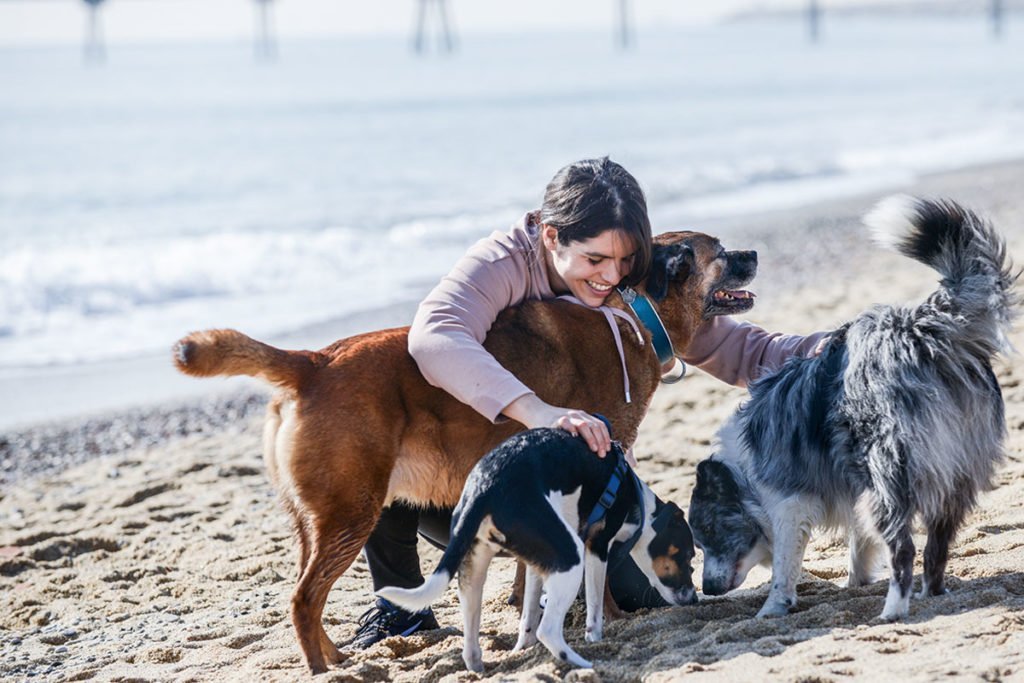We chatted with Patricia Guerrero, creator of “Pat Educadora Canina” (Pat Canine Educator), a community and platform that houses educational resources on canine training focused on humans, not just dogs.
Mexico has much to learn about animal rights and protection. Training has become indispensable in a country where 70% of the dogs are strays, and the abandonment of dogs and cats in natural areas is so high that it has endangered many protected species. I do not mean César Millán-style dog training schools (which use antiquated theories and encourage aggression). I am referring to training focused on people, on humans who live and cohabit with pets.
A few months ago, I was fortunate to be introduced to Patricia Guerrero and her project PAT Educadora Canina. More than a canine educator, Patricia considers herself a popularizer, canine improviser, and trainer of “piracanes” (a piracan “is a dog that feels free, happy and occasionally rebellious”). Her project’s goal is that humans and dogs learn to live together and communicate, i.e., “be living with the dogs.” A mutual colleague introduced us because he knows that the subject interests me personally and is aware there is a massive lack of training and awareness on animal rights in formal education. In the classroom, there is no talk, or little talk, about this topic.
I chatted for a long time with Patricia (“Pat,” as she is affectionately called) via Zoom, and she introduced me to her project and the team of trainers who support her. PAT Educadora Canina’s website has free and paid courses, challenges, and mini-courses on core topics such as canine language, smelling games, and traveling with dogs. In addition, there is the Dog Wellness Club, a community for “people who want to feel accompanied in their process of improving their dog-human relationship.” Pat also has a podcast and a free weekly newsletter. Pat’s platform is both a community and a trustworthy repository of educational resources on canine learning.
I wanted to delve into these topics with Pat to share with the Observatory community the importance of promoting respect for animals from an early age (and why not in the classroom?).
Below, I share the interview (edited for this medium and translated from the original Spanish).
Why is PAT a school for people and not only for dogs?
My vision regarding the relationship between dogs and humans is one of a team. Their wellbeing depends on us because we are the ones who decide their needs: their outings, food, mental stimulation (yes, the dog also needs that), rest …
Dogs observe and know humans very well. In fact, they continuously communicate with them. On the other hand, a human does not have the same knowledge about a dog. So the one who must be helped to understand, build confidence, motivate and guide is the human.
What is the difference between this human focus and traditional dog training?
History shows us that dog training without considering the dog’s wellbeing is not a way of respect. If we make a parallel with education, we are currently discussing the urgent need to leave traditional instruction behind to migrate to training focused on people, on the student. Then, why not suggest the same for other types of relationships, like the duo human-dog?
Tell us about the methodology you use; how do you combine online training with play?
I began this project by focusing on all the learning from the canine game, a fun, enjoyable, and formative way to learn. Now we attach the same importance to the canine game as the human and combine them.
Online training offers a range of endless possibilities to reach all types of people and create experiences beyond the screen. So, through applications, exercises, virtual meetings, conversation groups, and other things, I invite humans to play…also with their dogs :).
Is it possible to do distance dog training? How does it work?
Reality trumps fiction. Eight years ago, I started this project with a dream: to reach multitudes of dogs (through their human families), regardless of their context or location, accessibly and affordably. At that time, it was not easy for others to visualize what I had in mind. Now it is a reality.
Students have access to multiple formats: challenge-practice videos, audios, infographics, games, live sessions… all to teach and motivate them to put things into practice in “offline” life. We offer students different types of courses: live (real-time with their peers), deferred (consumed at their pace whenever convenient), and long-term accompaniment (in communities for guidance, support, and motivation over time).
You learn through the screen and apply the learning outdoors with the dogs.
I do not think the question lies with whether we relate online or offline; what matters is the depth of that relationship. With virtual tools, I can guide and teach in more depth than when I was only face-to-face. The follow-up is much closer, and students can repeat and absorb the concepts with more tranquility and efficiency.
What innovative teaching methodologies do you use?
The key to canine learning is practice, so we motivate action through challenges and canine missions. These are practical exercises, short and powerful, teaching the humans to know the why and how and apply it in their situation. Therein lies the difficulty in canine education, learning how to adjust it correctly to each dog. Hence, we enhance the critical sense and deep knowledge of what is happening.
From what I have observed in my sector, something we do differently is the tandem treatment for the human-dog team. We offer tools for both, supported by professionals in psychology, teaching, and human communication.
As in many other aspects of our lives, communication is key. Coexistence with our dogs is no exception; communication is vital, and to achieve this, we need to understand canine language. What is canine language, and how can we learn it?
All languages require knowledge of the rules, observation, and a lot of practice. In the case of dogs, most of their communication is non-verbal, and a human also communicates a lot through gestures and postures. In our case, most of the time, we internalize the gestures of other humans unconsciously.
With dogs, it is essential to have awareness and pay attention to what they are communicating, just like they do with us. Anyone who lives with dogs will have noticed the high level of observation offered by
our canine companions. The fair thing to do would be to give them the same attention, right?
With the pandemic and lockdowns came a boom in pet adoptions and purchases, especially puppies; however, now that we are all slowly returning to the “new normal,” many people are abandoning their pets. Unfortunately, this is a situation that has been occurring since long before the pandemic. How can we create awareness and sensitivity that animals are not toys or objects that can be returned?
The key is empathy and knowing what it takes to share life with a dog. Many humans do not understand the real needs of a dog. That, together with not putting themselves in their paws, causes people to have a distorted vision of living with a dog. If we add to that the egocentrism of humans, we have dogs carrying backpacks, something not natural to them.
For me, salvation is education that comes from motivation. I think we learn much better by focusing on the positive and leaving aside the negative. When a human feels judged and recriminated, he closes up and, in the end, makes drastic decisions, such as abandoning the dog. On the other hand, when we offer alternatives, understanding, and support, and do not judge… it can turn that overwhelming situation into a fun challenge to overcome as a family. So, empathy and knowledge would be for everyone: professionals, families, institutions, and a long etcetera.
I dream and work towards a healthy canine culture, where people condemn bad practices like abandonment out of affection for dogs. This is in the hands of everyone.
On this subject, I think respect for animals, plants, and other species must be taught in the home and in primary education. These bad practices often come from home, where children learn that a dog can be a gift or a toy. Do you have any training or outreach programs for children?
Over the years, I have collaborated on multiple educational projects, above all focusing on children at risk of social exclusion. And it is incredible how the children themselves reflect on their grandparents’ and parents’ practices regarding animals. They are even the ones who educate at home.
Some understand that their grandparents have not known to do better. In Galicia, where I live, it is still common to see dogs tied to chains all their lives. It is something that was always done that way. At the same time, you observe how young people treat dogs with respect. Momentum from the younger generations will be essential.
We are working to introduce short programs in educational institutions, in a workshop format, where we offer two options:
-
Didactic materials and guides so that teachers can work autonomously with their students.
-
A virtual workshop shows the need to build respectful relationships between humans and animals, whether dogs or other species. Education is the only way to change things.
Lastly, tell us about your book, “The Best Educator for Your Dog Is You,” and give us some clues about the new book you are writing.
The book The Best Educator for Your Dog is You (‘El mejor educador para tu perro eres tú’) is very informative. It is an overview of the wide range of possibilities that open up to you when you live with a dog. It aims that the human and the dog live a collaborative experience.
It is a hybrid book, combining written and online content. It is a fantastic way to complement and nurture the two worlds.
And with that same premise comes the new book, which began as a diary and evolved into something different. It is a compendium of 50 hybrid canine challenges. Each tab in the written book proposes a challenge, which is supplemented with online content. These include games, videos, lessons, and virtual walls to share experiences regarding combining canine and human play.
The book 50 Canine Challenges, designed to initiate anyone to the canine’s world to build a meaningful relationship with their dog, is now available for pre-sale on our website pateducadoracanina.com. It is an ideal Christmas gift!
You can find more information about PAT Canine Educator on:
And at pateducadoracanina.com
Translation by Daniel Wetta
This article from Observatory of the Institute for the Future of Education may be shared under the terms of the license CC BY-NC-SA 4.0 
)
)



)